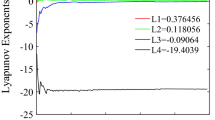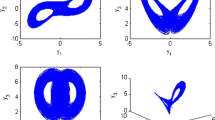Abstract
In order to construct the high-dimensional discrete hyperchaotic systems systemically, this paper proposes a new coupled chaotic model. It has a wide chaotic parameter range and can relax the election of the coupling coefficient. Sufficient conditions are derived to prove the existence of Li–Yorke chaos in the proposed model. Meanwhile, the existence of hyperchaos is also demonstrated. To discern the effects of different coupling types on the chaotic dynamics more comprehensively, we further explore the dynamical behaviors with various coupling structures by using Lyapunov spectrum, bifurcation analysis, and phase portraits. We investigate the interaction relationship between coupled units and give suggestions for selecting coupling types. The results indicate that the coupled model has more complex and more stable chaotic performance when there exists a loop in its topological structure. Further, synchronization is also discussed in this work; analysis results illustrate that the proposed model cannot be suppressed to periodic points at sufficiently high coupling strengths. This paper suggests an effective method that may contribute to studying hyperchaos design and coupled chaotic systems.





















Similar content being viewed by others
Data availability
The datasets generated during and/or analyzed during the current study are available from the corresponding author on reasonable request.
References
Wu, G.C., Baleanu, D.: Discrete fractional logistic map and its chaos. Nonlinear Dyn. 75, 283–287 (2014)
Guegan, D.: Chaos in economics and finance. Annu. Rev. Control 33, 89–93 (2009)
Kocarev, L.: Chaos-based cryptography: a brief overview. IEEE Circuits Syst. Mag. 1, 6–21 (2002)
Zheng, J., Hu, H., Xiang, X.: Applications of symbolic dynamics in counteracting the dynamical degradation of digital chaos. Nonlinear Dyn. 94, 1535–1546 (2018)
Bao, H., Hu, A., Liu, W., Bao, B.: Hidden bursting firings and bifurcation mechanisms in memristive neuron model with threshold electromagnetic induction. IEEE Trans. Neural Netw. Learn. Syst. 31, 502–511 (2020)
Wang, X., Qin, X.: A new pseudo-random number generator based on cml and chaotic iteration. Nonlinear Dyn. 70, 1589–1592 (2012)
Hu, H.P., Liu, L.F., Ding, N.D.: Pseudorandom sequence generator based on the chen chaotic system. Comput. Phys. Commun. 184, 765–768 (2013)
Broumandnia, A.: The 3d modular chaotic map to digital color image encryption. Future Gener. Comput. Syst. 99, 489–499 (2019)
Hua, Z., Zhou, Y., Huang, H.: Cosine-transform-based chaotic system for image encryption. Inf. Sci. 480, 403–419 (2019)
Hua, Z., Zhou, Y., Pun, C.M., Chen, C.: 2d sine logistic modulation map for image encryption. Inf. Sci. 297, 80–94 (2015)
Zhang, Y.Q., Wang, X.Y.: A symmetric image encryption algorithm based on mixed linear–nonlinear coupled map lattice. Inf. Sci. 273, 329–351 (2014)
Özkaynak, F.: Brief review on application of nonlinear dynamics in image encryption. Nonlinear Dyn. 92, 305–313 (2018)
Li, Y., Tang, W.K., Chen, G.: Hyperchaos evolved from the generalized Lorenz equation. Int. J. Circuit Theory Appl. 33, 235–251 (2005)
Shen, C., Yu, S., Lu, J., Chen, G.: Designing hyperchaotic systems with any desired number of positive lyapunov exponents via a simple model. IEEE Trans. Circuits Syst. I Regul. Pap. 61, 2380–2389 (2014)
Li, Y., Chen, G., Tang, W.K.S.: Controlling a unified chaotic system to hyperchaotic. IEEE Trans. Circuits Syst. II Express Briefs 52, 204–207 (2005)
Sun, K., Xuan, L., Zhu, C., Sprott, J.C.: Hyperchaos and hyperchaos control of the sinusoidally forced simplified Lorenz system. Nonlinear Dyn. 69, 1383–1391 (2012)
Cafagna, D., Grassi, G.: Hyperchaotic coupled Chua circuits: an approach for generating new n \(\times \) m-scroll attractors. Int. J. Bifurc. Chaos 13, 2537–2550 (2003)
Wang, J., Chen, Z., Chen, G., Yuan, Z.: A novel hyperchaotic system and its complex dynamics. Int. J. Bifurc. Chaos 18, 3309–3324 (2008)
Shen, C., Yu, S., Lu, J., Chen, G.: A systematic methodology for constructing hyperchaotic systems with multiple positive Lyapunov exponents and circuit implementation. IEEE Trans. Circuits Syst. I Regul. Pap. 61, 854–864 (2014)
Kong, S., Li, C., Jiang, H., Lai, Q., Jiang, X.: A 2d hyperchaotic map with conditional symmetry and attractor growth. Chaos 31, 043121 (2021)
Natiq, H., Banerjee, S., Said, M.: Cosine chaotification technique to enhance chaos and complexity of discrete systems. Eur. Phys. J. Spec. Top. 228, 185–194 (2019)
Peng, Y., He, S., Sun, K.: A higher dimensional chaotic map with discrete memristor. AEU Int. J. Electron. Commun. 129, 153539 (2021)
Bao, B.C., Li, H., Wu, H., Zhang, X., Chen, M.: Hyperchaos in a second-order discrete memristor-based map model. Electron. Lett. 56(15), 769–770 (2020)
Chen, G., Lai, D.: Feedback control of Lyapunov exponents for discrete-time dynamical systems. Int. J. Bifurc. Chaos 6, 1341–1349 (1996)
Wang, X.F., Chen, G.: On feedback anticontrol of discrete chaos. Int. J. Bifurc. Chaos 9, 1435–1441 (1999)
Chen, C., Sun, K., He, S.: A class of higher-dimensional hyperchaotic maps. Eur. Phys. J. Plus 134, 410 (2019)
Liu, W., Sun, K., He, S.: Sf-simm high-dimensional hyperchaotic map and its performance analysis. Nonlinear Dyn. 89, 2521–2532 (2017)
Shakiba, A.: A novel 2d cascade modulation couple hyperchaotic mapping for randomized image encryption. Multimed. Tools Appl. 80, 17983–18006 (2021)
Singha, J., Gupte, N.: Chimera states in globally coupled sine circle map lattices: spatiotemporal intermittency and hyperchaos. Phys. Lett. A 384, 126225 (2020)
Wang, X., Zhao, H., Feng, L., Ye, X., Zhang, H.: High-sensitivity image encryption algorithm with random diffusion based on dynamic-coupled map lattices. Opt. Lasers Eng. 122, 225–238 (2019)
Batista, C.A., Viana, R.L.: Chaotic maps with nonlocal coupling: Lyapunov exponents, synchronization of chaos, and characterization of chimeras. Chaos Solitons Fract. 131, 109501 (2020)
Chazottes, J.R., Fernandez, B.: Dynamics of Coupled Map Lattices and Related Spatially Extended Systems. Springer, Berlin (2005)
Rajvaidya, B.P., Deshmukh, A.D., Gade, P.M., Sahasrabudhe, G.G.: Transition to coarse-grained order in coupled logistic maps: effect of delay and asymmetry. Chaos Solitons Fract. 139, 110301 (2020)
Wang, S., Hu, G., Zhou, H.: A one-way coupled chaotic map lattice based self-synchronizing stream cipher. Commun. Nonlinear Sci. Numer. Simul. 19, 905–913 (2014)
Nag, M., Poria, S.: Li–Yorke chaos in globally coupled map lattice with delays. Int. J. Bifurc. Chaos 29, 1950183 (2019)
Nag, M., Poria, S.: Effects of time delay on the synchronized states of globally coupled network. Chaos 30, 093122 (2020)
Chaurasia, S.S., Sinha, S.: Suppression of chaos through coupling to an external chaotic system. Nonlinear Dyn. 87, 159–167 (2017)
Collet, P., Eckmann, J.P.: Iterated Maps on the Interval as Dynamical Systems. Springer, Berlin (2009)
Pincus, S.M.: Approximate entropy as a measure of system complexity. Proc. Natl. Acad. Sci. U. S. A. 88, 2297–2301 (1991)
Marotto, F.R.: On redefining a snap-back repeller. Chaos Solitons Fract. 25, 25–28 (2005)
Chen, G., Shi, Y.: Introduction to anti-control of discrete chaos: theory and applications. Philos. Trans. R. Soc. A Math. Phys. Eng. Sci. 364, 2433–2447 (2006)
Eckmann, J., Ruelle, D.: Ergodic theory of chaos and strange attractors. Rev. Mod. Phys. 57(3), 1115–1115 (2008)
Vasegh, N.: Spatiotemporal and synchronous chaos in accumulated coupled map lattice. Nonlinear Dyn. 89, 1089–1097 (2017)
Batista, C.A.S., Batista, A.M., de Pontes, J.A.C., Viana, R.L., Lopes, S.R.: Chaotic phase synchronization in scale-free networks of bursting neurons. Phys. Rev. E 76, 016218 (2007)
Perego, A., Lamperti, M.: Collective excitability, synchronization, and array-enhanced coherence resonance in a population of lasers with a saturable absorber. Phys. Rev. A 94, 033839 (2016)
Acknowledgements
This work was supported by the National Key R&D Program of China [Grant Number 2017YFB0802000]; and the Cryptography Theoretical Research of National Cryptography Development Fund [Grant Number MMJJ20170109]; and the Key R&D Program of Hubei Province [Grant Number 2020BAB104].
Author information
Authors and Affiliations
Corresponding author
Ethics declarations
Conflict of interest
The authors declare that they have no conflict of interest concerning the publication of this manuscript.
Additional information
Publisher's Note
Springer Nature remains neutral with regard to jurisdictional claims in published maps and institutional affiliations.
Rights and permissions
About this article
Cite this article
Ming, H., Hu, H. & Zheng, J. Analysis of a new coupled hyperchaotic model and its topological types. Nonlinear Dyn 105, 1937–1952 (2021). https://doi.org/10.1007/s11071-021-06692-w
Received:
Accepted:
Published:
Issue Date:
DOI: https://doi.org/10.1007/s11071-021-06692-w




